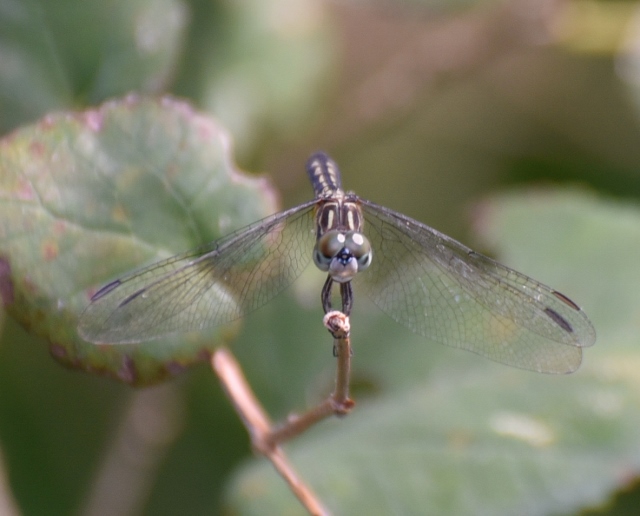August slipped into September while I wasn’t paying attention. Regardless, my favorite bugs are still hanging around — the cicadas sing, and the dragons fly.
Hundreds of dragonflies floating on the airwaves is nearly the only typical in this, a year of peculiarities. The spring saw less insect activity; plants struggled to renew after the dastardly winter freeze. The summer hum was quieter with seemingly less cicada activity and the yard so much less colorful with the absence of the usual number of butterflies, even as many plants showed recovery.
Happily, as September deepens, so do the voices of the cicadas, and the legions of dragonflies thicken as each species races to fulfill its annual mission.
There are possibly 54 species of cicadas in Texas. Not all of them sing, or if they do, not at human pitch.
I’ve photographed five different species in our yard; the smallest is the little mesquite, at about three-quarters of an inch long. I’ve also documented the scrub, giant, and superb dog-day cicadas. Tentative identification is of a resh cicada that I found on a wild olive fruit this year. I await confirmation at www.iNaturalist.org.


For those new to this blog, previous cicada articles are at these links:
A slight year for cicadas; a great year for dragonflies! Texas may have 250 different species of dragonflies and damselflies (order Odonata) — you may know dragonflies perch with their wings spread; damselflies rest with their wings closed above their abdomen.


The abundance of their late August/early September activity is on par with previous years. The dragonflies, with all of their amazing colors, show off their aerial aerobatics around me as I work in the yard. Orange, green, yellow, black, brown, red and blue are visible as they zip around with a flexibility like no other insect.
I’ve challenged myself to photograph as many species as I can. That’s no easy feat for those of us with only a modicum of patience. However, I’m determined to have success in spite of the amazing maneuverability of the dragonfly. Here’s what the unsuspecting photographer is up against: Dragonflies can move each of their four wings independently to flap up and down and rotate forward and backward, allowing dragonflies to fly up, down, backwards, sideways, hover like a helicopter and make hairpin turns in the blinking of an eye.


The wing gyrations aren’t the only challenge. Nearly all of a dragonfly’s head consists of two huge compound eyes that give it nearly 360-degree vision — consider approaching the insect directly from behind. Or use a camera with a telephoto lens.

Here’s another tip — if you have the patience for it. As you probably already have witnessed, dragonflies rest mostly at the tip of something — twig, snag, top of tree, a lone stick stuck in the ground or on the grass — really, anywhere. Dragonflies rest a lot — it’s a time for them to recharge their body and brain. With this in mind, approach a resting dragonfly with camera or phone app at the ready. The dragonfly will fly away, of course, but stay where you are and have your camera focused on where the dragonfly was. The dragonfly more often than not will come back to the perch it was on before you caused it to flee – or very near it.



Dragonflies aren’t harmful to humans or the universe — quite the opposite. Their unique flight skills and remarkable vision help them quickly detect the movement of other insects. They eat on the fly and catch their prey by grabbing it with their feet. Their diet includes mosquitoes, flies, gnats, even butterflies and smaller dragonflies. A single dragonfly can eat hundreds of mosquitoes a day. Even with such remarkable sight and flight proficiencies, they are not without enemies. Birds and frogs eat dragonflies, and spider webs can imprison a dragonfly for a spider’s next meal.
A couple of years ago I was photographing for a bioblitz. Several small, quad-winged insects were hovering around the blooms on skeleton leaf golden eye shrubs. The insects were so small they could have fit on a quarter coin. Their most eye-catching trait was that their wings glowed a brilliant orange with a vibrancy enhanced by direct sunshine. Aptly, they were identified as amberwings. Amberwings are dragonflies.


I purposefully set out recently in the late summer heat to see if the amberwings had returned to their fav hangout; I found a couple, but they seemed more skittish than in previous years. Although amberwings hang out at those shrubs and specifically perch on the flowers, they aren’t considered pollinators. They don’t feed on nectar or pollen. What they’re after are the tiny flying insects like midges, flower flies and tiny bees. They catch on the wing and then perch to eat their prey. Their second favorite hangout is water, still water especially, like ponds and resacas where they perch on the tips of snags or other platforms.

Male amberwings have solid orange wings; female wings have dark spots. Both have yellowish legs and their abdomens have rings around the segments. Amberwings are considered wasp mimics. The abdominal rings are one of the traits that establishes their ability to mimic wasps. Other wasplike antics to protect them from aerial and terrestrial predators are their rapid, erratic flight, and the twitch of their wings and abdomens when at rest.

– 30 –


Leave a Reply